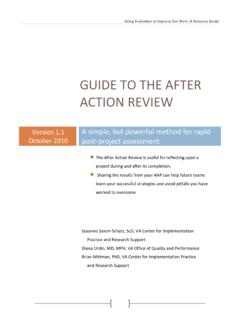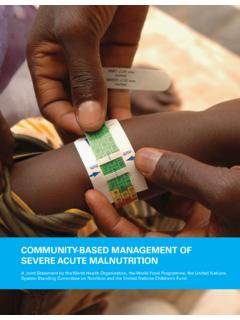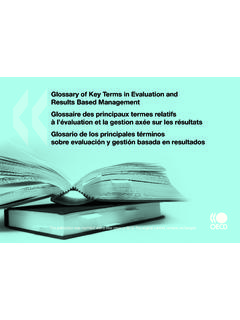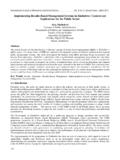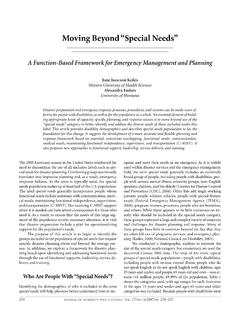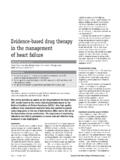Transcription of I. Introduction Envisioning Evidence-Based Management
1 19 I. Introduction Envisioning Evidence-Based Management Denise M. Rousseau, Carnegie Mellon University Abstract Evidence-Based Management (EBMgt) is an evolution in the practice of Management . It is a knowledge-intensive, capacity-building way to think, act, organize and lead. Its practice incorporates 1) use of scientific principles in decisions and Management processes, 2) systematic attention to organizational facts, 3) advancements in practitioner judgment through critical thinking and decision aids that reduce bias and enable fuller use of information and 4) ethical considerations including effects on stakeholders. It is a no-fad, no-fluff approach to developing better managers and leading effective and adaptive organizations.
2 EBMgt is a product of the distinct yet interdependent activities of practitioners, educators and scholars. This chapter discusses how each contribute to the advancement and use of EBMgt. Keywords: Scientific evidence Organizational facts as evidence Systematic decision making Ethics Critical thinking Decision Aids Cognitive repair Logic models Cognitive bias Bounded rationality Practice-oriented research 20 Management means, in the last analysis, the substitution of thought for brawn and muscle, of knowledge for folklore and superstition, and of cooperation for Peter Drucker In science you need to understand the world; in business you need others to misunderstand it.
3 Nassim Nicholas Taleb The world is complex and experience meager. James G. March Evidence-Based Management (EBMgt) is the systematic, evidence -informed practice of Management , incorporating incorporates scientific knowledge in the content and process of making decisions. Part of a broad movement to make better use of scientific knowledge in everyday life, EBMgt is an evolution in Management practice and the way professional managers are educated. It deploys well-established scientific findings regarding critical thinking, human judgment, and decision making to aid managers in obtaining quality information and putting it to use. The set of practices that make up EBMgt achieve better-quality results in organizations by improving the practitioner s knowledge, judgment, and competencies.
4 EBMgt offers no one-size-fits-all solutions. It does not oversimplify problems and their solutions in the way that Management fads tend to do (Huczynski, 2006). Instead, it supports practitioners in making fuller use of their human, social and technological capabilities. EBMgt is developed and mastered over a career, not a course. This chapter first introduces the basic facets of EBMgt and how they can be practiced. It then describes how Evidence-Based approaches can be adapted to the broad array of situations managers face. It concludes by describing the roles of 21 EBMgt s three critical constituencies: (1) the managers, consultants and others who practice EBMgt and the (2) educators and (3) scholars who provide it critical support.
5 But first, to help the reader envision what EBMgt practitioners actually do, let s meet two of them: Frances Tan, an executive in a global corporation, and Normand Mathieu, a middle manager in a regional bank. What practices are they using that seem Evidence-Based to you? Frances Tan is the marketing vice president of an international container and packaging firm. She is on the lookout for ways to improve how her division organizes work and makes decisions. Frances champions her staff s development and their efforts to make better decisions. She and her direct reports collaborated with a consulting psychologist to turn a set of principles from decision-making research into practical guidelines for improving their decisions.
6 These covered advance preparation, processes for making an actual decision, and managing its aftermath. At meetings and when she teaches in the company s in-house leadership program, Frances reinforces these principles. At the end of meetings where decisions are made, her staff now takes a few minutes to talk about how they applied the principles and what they learned. These discussions have helped adapt and expand the use of Evidence-Based decision principles to the division s array of decisions. The results so far include (1) more consistent decision follow through and (2) fewer unexpected customer or employee problems as a consequence of decisions. Normand Mathieu is the institutional research director for a large bank.
7 As part of his role, Normand regularly analyzes bank data to help address critical 22 questions the bank s top Management team has raised. Searching for ways to improve his Management practice, he uses the bank s electronic library to follow research in relevant areas. Recently he looked into the research on demographic diversity. These studies led Normand to examine the results of a naturally occurring experiment inside the bank: comparing units that had included diversity in their performance goals to those that hadn t. Findings from this analysis demonstrated that certain practices led to better retention and advancement of women and minorities at the bank. They also highlighted ways to reduce backlash from white men to the bank s diversity efforts.
8 As a result, Normand changed certain practices in his own group and provided senior Management with information on diversity-promoting practices that work at the bank. Appendix 1 lists Evidence-Based practices used by these two practitioners. As we go through the chapter, I will provide more details about how they practice EBMgt. The practices Frances and Normand use reflect EBMgt s four facets. The Four Facets of EBMgt Think for yourself upon rational lines, hypothesize, test against the evidence , never accept that a question has been answered as well as it ever will be. Billy Beane EBMgt combines four fundamental activities in the everyday exercise of Management judgment and decision-making (Figure 1): 1.
9 Use of the best available scientific findings; 2. Gathering and attending to organizational facts, indicators and metrics in a systematic fashion to increase their reliability and usefulness; 3. On-going use of critical, reflective judgment and decision aids in order to reduce bias and improve decision quality; 23 4. Consideration of ethical issues including the short- and long-term impact of decisions on stakeholders. ---------- Insert Figure 1 about here ---------- These facets are implemented in ways that surmount the limitations and constraints that operate on unaided human judgment (Simon, 1997). EBMgt s features are intended to improve information quality while at the same time providing cognitive aids and decision tools to repair and develop practitioner judgment and decision making (cf.)
10 Heath, Larrick & Klayman, 1998). Use of Best Available Scientific Findings Research is to see what everybody else has seen, and to think what nobody else has thought. Albert Szent-Gy rgi It's not that I'm so smart, it's just that I stay with problems longer. Albert Einstein Scientific knowledge is the bedrock of all Evidence-Based approaches to practice, from medicine (Sackett et al., 2000) to criminology (Sherman, 2002) to education (Ambrose et al., 2010; Thomas & Pring, 2004). EBMgt is built on the scientific premise that there is an underlying degree of order in which a common set of basic physical, biological, social and psychological processes occur. The distinctive value of scientific evidence is the explicit knowledge it provides regarding how the world operates.


